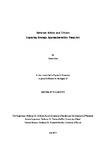Between Selves and Others: Exploring Strategic Approaches within Visual Art
| dc.contributor.supervisor | Scott, Jill | |
| dc.contributor.author | Chen, Teresa | |
| dc.contributor.other | Faculty of Arts, Humanities and Business | en_US |
| dc.date.accessioned | 2014-09-16T10:04:07Z | |
| dc.date.available | 2014-09-16T10:04:07Z | |
| dc.date.issued | 2014 | |
| dc.identifier | 10072225 | en_US |
| dc.identifier.uri | http://hdl.handle.net/10026.1/3106 | |
| dc.description | Full version unavailable due to 3rd party copyright restrictions. | |
| dc.description.abstract |
This body of research investigates how visual artists express ideas or meanings about Otherness and issues of belonging in their art. The focus of this study is on women artists with an (East) Asian diasporic background; however, the context of the inquiry includes other American and European artists of various cultural backgrounds. A further aim is to explore the artistic strategies and the historical circumstances of the works as well as to understand the theoretical correlations. The author of this study is a visual artist who has been exploring similar issues in her own artistic practice. In order to examine various themes of Otherness, selected pairs of artists – where at least one is a woman artist of (East) Asian diasporic background – are compared and analysed using the following four categories: literary devices (such as irony, parody, connotation or juxtaposition), reappropriation (cultural references which are reclaimed and transformed), anamorphic situations (distortion of conventional ways of viewing in order to become aware of other bodily senses and experiences), and theoretical correlations (connections between artistic practice and relevant theoretical concepts). The specific artists and artworks chosen are: Yoko Ono’s Cut Piece (1965) with Patty Chang’s Melons (at a Loss) (1998), Lorna Simpson’s work in the 1980s and 1990s with Nikki S. Lee’s Projects (1997-2001), Guillermo Gómez-Peña with Fiona Tan, and Yong Soon Min with Mona Hatoum. In addition, the author presents critical social and cultural developments that influenced these works such as the historical background of representations of Asian women in America, the rise of the Asian American movement, and the shift in contemporary art discourse from concerns of ‘identity politics’ to a ‘post-identity’ framework. Finally, correlations are made between the artistic strategies and relevant theoretical discussions about representations of race and gender, the role of power, knowledge, and truth in ethnographic practices of identification and categorization, and the function of place and ‘cultural identity’ in relation to concepts of origin and belonging. The results of this research confirm the significance of cultural, historical, and geographic experiences on both the conception and reception of visual art and indicate that various artistic strategies have the potential to expose and undermine culturally constructed meanings of difference. Despite the abundance of research conducted in this area, the scope and framework of this particular study are original not only because it is written from the perspective of a practicing artist, but also because the focus on artistic practices from women artists with (East) Asian diasporic backgrounds is located within a more wide-ranging investigation of artistic approaches that articulate and interrogate themes of Otherness. | en_US |
| dc.language.iso | en | en_US |
| dc.publisher | Plymouth University | en_US |
| dc.subject | Contemporary Fine Arts | en_US |
| dc.subject | Otherness | |
| dc.subject | East Asian women | |
| dc.title | Between Selves and Others: Exploring Strategic Approaches within Visual Art | en_US |
| dc.type | Thesis | |
| plymouth.version | Edited version | en_US |
| dc.identifier.doi | http://dx.doi.org/10.24382/3436 | |
| dc.identifier.doi | http://dx.doi.org/10.24382/3436 |
Files in this item
This item appears in the following Collection(s)
-
01 Research Theses Main Collection
Research Theses Main


